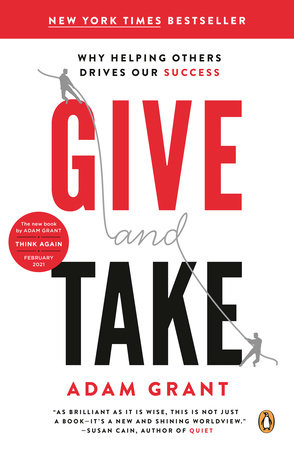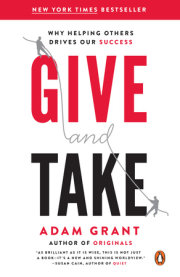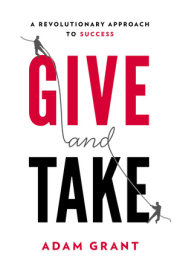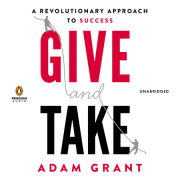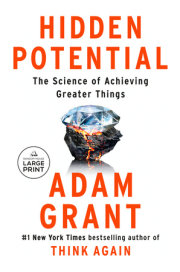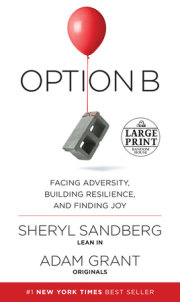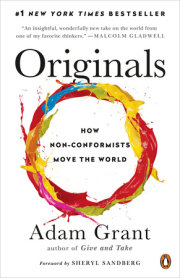1
Good Returns
The Dangers and Rewards of Giving More Than You Get The principle of give and take; that is diplomacy—give one and take ten.
—Mark Twain, author and humorist
On a sunny Saturday afternoon in Silicon Valley, two proud fathers stood on the sidelines of a soccer field. They were watching their young daughters play together, and it was only a matter of time before they struck up a conversation about work. The taller of the two men was Danny Shader, a serial entrepreneur who had spent time at Netscape, Motorola, and Amazon. Intense, dark-haired, and capable of talking about business forever, Shader was in his late thirties by the time he launched his first company, and he liked to call himself the “old man of the Internet.” He loved building companies, and he was just getting his fourth start-up off the ground.
Shader had instantly taken a liking to the other father, a man named David Hornik who invests in companies for a living. At 5'4", with dark hair, glasses, and a goatee, Hornik is a man of eclectic interests: he collects Alice in Wonderland books, and in college he created his own major in computer music. He went on to earn a master’s in criminology and a law degree, and after burning the midnight oil at a law firm, he accepted a job offer to join a venture capital firm, where he spent the next decade listening to pitches from entrepreneurs and deciding whether or not to fund them.
During a break between soccer games, Shader turned to Hornik and said, “I’m working on something—do you want to see a pitch?” Hornik specialized in Internet companies, so he seemed like an ideal investor to Shader. The interest was mutual. Most people who pitch ideas are first-time entrepreneurs, with no track record of success. In contrast, Shader was a blue-chip entrepreneur who had hit the jackpot not once, but twice. In 1999, his first start-up, Accept.com, was acquired by Amazon for $175 million. In 2007, his next company, Good Technology, was acquired by Motorola for $500 million. Given Shader’s history, Hornik was eager to hear what he was up to next.
A few days after the soccer game, Shader drove to Hornik’s office and pitched his newest idea. Nearly a quarter of Americans have trouble making online purchases because they don’t have a bank account or credit card, and Shader was proposing an innovative solution to this problem. Hornik was one of the first venture capitalists to hear the pitch, and right off the bat, he loved it. Within a week, he put Shader in front of his partners and offered him a term sheet: he wanted to fund Shader’s company.
Although Hornik had moved fast, Shader was in a strong position. Given Shader’s reputation, and the quality of his idea, Hornik knew plenty of investors would be clamoring to work with Shader. “You’re rarely the only investor giving an entrepreneur a term sheet,” Hornik explains. “You’re competing with the best venture capital firms in the country, and trying to convince the entrepreneur to take your money instead of theirs.” The best way for Hornik to land the investment was to set a deadline for Shader to make his decision. If Hornik made a compelling offer with a short fuse, Shader might sign it before he had the chance to pitch to other investors. This is what many venture capitalists do to stack the odds in their favor.
But Hornik didn’t give Shader a deadline. In fact, he practically invited Shader to shop his offer around to other investors. Hornik believed that entrepreneurs need time to evaluate their options, so as a matter of principle, he refused to present exploding offers. “Take as much time as you need to make the right decision,” he said. Although Hornik hoped Shader would conclude that the right decision was to sign with him, he put Shader’s best interests ahead of his own, giving Shader space to explore other options.
Shader did just that: he spent the next few weeks pitching his idea to other investors. In the meantime, Hornik wanted to make sure he was still a strong contender, so he sent Shader his most valuable resource: a list of forty references who could attest to Hornik’s caliber as an investor. Hornik knew that entrepreneurs look for the same attributes in investors that we all seek in financial advisers: competence and trustworthiness. When entrepreneurs sign with an investor, the investor joins their board of directors and provides expert advice. Hornik’s list of references reflected the blood, sweat, and tears that he had devoted to entrepreneurs over the course of more than a decade in the venture business. He knew they would vouch for his skill and his character.
A few weeks later, Hornik’s phone rang. It was Shader, ready to announce his decision.
“I’m sorry,” Shader said, “but I’m signing with another investor.” The financial terms of the offer from Hornik and the other investor were virtually identical, so Hornik’s list of forty references should have given him an advantage. And after speaking with the references, it was clear to Shader that Hornik was a great guy.
But it was this very same spirit of generosity that doomed Hornik’s case. Shader worried that Hornik would spend more time encouraging him than challenging him. Hornik might not be tough enough to help Shader start a successful business, and the other investor had a reputation for being a brilliant adviser who questioned and pushed entrepreneurs. Shader walked away thinking, “I should probably add somebody to the board who will challenge me more. Hornik is so affable that I don’t know what he’ll be like in the boardroom.” When he called Hornik, he explained, “My heart said to go with you, but my head said to go with them. I decided to go with my head instead of my heart.”
Hornik was devastated, and he began to second-guess himself. “Am I a dope? If I had applied pressure to take the term sheet, maybe he would have taken it. But I’ve spent a decade building my reputation so this wouldn’t happen. How did this happen?”
David Hornik learned his lesson the hard way: good guys finish last.
Or do they?
According to conventional wisdom, highly successful people have three things in common: motivation, ability, and opportunity. If we want to succeed, we need a combination of hard work, talent, and luck. The story of Danny Shader and David Hornik highlights a fourth ingredient, one that’s critical but often neglected: success depends heavily on how we approach our interactions with other people. Every time we interact with another person at work, we have a choice to make: do we try to claim as much value as we can, or contribute value without worrying about what we receive in return?
As an organizational psychologist and Wharton professor, I’ve dedicated more than ten years of my professional life to studying these choices at organizations ranging from Google to the U.S. Air Force, and it turns out that they have staggering consequences for success. Over the past three decades, in a series of groundbreaking studies, social scientists have discovered that people differ dramatically in their preferences for reciprocity— their desired mix of taking and giving. To shed some light on these preferences, let me introduce you to two kinds of people who fall at opposite ends of the reciprocity spectrum at work. I call them takers and givers. Takers have a distinctive signature: they like to get more than they give.
They tilt reciprocity in their own favor, putting their own interests ahead of others’ needs. Takers believe that the world is a competitive, dog-eat-dog place. They feel that to succeed, they need to be better than others. To prove their competence, they self-promote and make sure they get plenty of credit for their efforts. Garden-variety takers aren’t cruel or cutthroat; they’re just cautious and self-protective. “If I don’t look out for myself first,” takers think, “no one will.” Had David Hornik been more of a taker, he would have given Danny Shader a deadline, putting his goal of landing the investment ahead of Shader’s desire for a flexible timeline.
But Hornik is the opposite of a taker; he’s a giver. In the workplace, givers are a relatively rare breed. They tilt reciprocity in the other direction, preferring to give more than they get. Whereas takers tend to be self-focused, evaluating what other people can offer them, givers are other-focused, paying more attention to what other people need from them. These preferences aren’t about money: givers and takers aren’t distinguished by how much they donate to charity or the compensation that they command from their employers. Rather, givers and takers differ in their attitudes and actions toward other people. If you’re a taker, you help others strategically, when the benefits to you outweigh the personal costs. If you’re a giver, you might use a different cost-benefit analysis: you help whenever the benefits to others exceed the personal costs. Alternatively, you might not think about the personal costs at all, helping others without expecting anything in return. If you’re a giver at work, you simply strive to be generous in sharing your time, energy, knowledge, skills, ideas, and connections with other people who can benefit from them.
It’s tempting to reserve the giver label for larger-than-life heroes such as Mother Teresa or Mahatma Gandhi, but being a giver doesn’t require extraordinary acts of sacrifice. It just involves a focus on acting in the interests of others, such as by giving help, providing mentoring, sharing credit, or making connections for others. Outside the workplace, this type of behavior is quite common. According to research led by Yale psychologist Margaret Clark, most people act like givers in close relationships. In marriages and friendships, we contribute whenever we can without keeping score.
But in the workplace, give and take becomes more complicated. Professionally, few of us act purely like givers or takers, adopting a third style instead. We become matchers, striving to preserve an equal balance of giving and getting. Matchers operate on the principle of fairness: when they help others, they protect themselves by seeking reciprocity. If you’re a matcher, you believe in tit for tat, and your relationships are governed by even exchanges of favors.
Giving, taking, and matching are three fundamental styles of social interaction, but the lines between them aren’t hard and fast. You might find that you shift from one reciprocity style to another as you travel across different work roles and relationships. It wouldn’t be surprising if you act like 3a taker when negotiating your salary, a giver when mentoring someone with less experience than you, and a matcher when sharing expertise with a colleague. But evidence shows that at work, the vast majority of people develop a primary reciprocity style, which captures how they approach most of the people most of the time. And this primary style can play as much of a role in our success as hard work, talent, and luck.
In fact, the patterns of success based on reciprocity styles are remarkably clear. If I asked you to guess who’s the most likely to end up at the bottom of the success ladder, what would you say—takers, givers, or matchers? Professionally, all three reciprocity styles have their own benefits and drawbacks. But there’s one style that proves more costly than the other two. Based on David Hornik’s story, you might predict that givers achieve the worst results—and you’d be right. Research demonstrates that givers sink to the bottom of the success ladder. Across a wide range of important occupations, givers are at a disadvantage: they make others better off but sacrifice their own success in the process.
In the world of engineering, the least productive and effective engineers are givers. In one study, when more than 160 professional engineers in California rated one another on help given and received, the least successful engineers were those who gave more than they received. These givers had the worst objective scores in their firm for the number of tasks, technical reports, and drawings completed—not to mention errors made, deadlines missed, and money wasted. Going out of their way to help others prevented them from getting their own work done.
The same pattern emerges in medical school. In a study of more than six hundred medical students in Belgium, the students with the lowest grades had unusually high scores on giver statements like “I love to help others” and “I anticipate the needs of others.” The givers went out of their way to help their peers study, sharing what they already knew at the expense of filling gaps in their own knowledge, and it gave their peers a leg up at test time. Salespeople are no different. In a study I led of salespeople in North Carolina, compared with takers and matchers, givers brought in two and a half times less annual sales revenue. They were so concerned about what was best for their customers that they weren’t willing to sell aggressively. Across occupations, it appears that givers are just too caring, too trusting, and too willing to sacrifice their own interests for the benefit of others. There’s even evidence that compared with takers, on average, givers earn 14 percent less money, have twice the risk of becoming victims of crimes, and are judged as 22 percent less powerful and dominant. So if givers are most likely to land at the bottom of the success ladder, who’s at the top—takers or matchers?
Neither. When I took another look at the data, I discovered a surprising pattern: It’s the givers again.
As we’ve seen, the engineers with the lowest productivity are mostly givers. But when we look at the engineers with the highest productivity, the evidence shows that they’re givers too. The California engineers with the best objective scores for quantity and quality of results are those who consistently give more to their colleagues than they get. The worst performers and the best performers are givers; takers and matchers are more likely to land in the middle.
This pattern holds up across the board. The Belgian medical students with the lowest grades have unusually high giver scores, but so do the students with the highest grades. Over the course of medical school, being a giver accounts for 11 percent higher grades. Even in sales, I found that the least productive salespeople had 25 percent higher giver scores than average performers—but so did the most productive salespeople. The top performers were givers, and they averaged 50 percent more annual revenue than the takers and matchers. Givers dominate the bottom and the top of the success ladder. Across occupations, if you examine the link between reciprocity styles and success, the givers are more likely to become champs—not only chumps.
Guess which one David Hornik turns out to be?
After Danny Shader signed with the other investor, he had a gnawing feeling. “We just closed a big round. We should be celebrating. Why am I not happier? I was excited about my investor, who’s exceptionally bright and talented, but I was missing the opportunity to work with Hornik.” Shader wanted to find a way to engage Hornik, but there was a catch. To involve him, Shader and his lead investor would have to sell more of the company, diluting their ownership.
Shader decided it was worth the cost to him personally. Before the financing closed, he invited Hornik to invest in his company. Hornik accepted the offer and made an investment, earning some ownership of the company. He began coming to board meetings, and Shader was impressed with Hornik’s ability to push him to consider new directions. “I got to see the other side of him,” Shader says. “It had just been overshadowed by how affable he is.” Thanks in part to Hornik’s advice, Shader’s start-up has taken off. It’s called PayNearMe, and it enables Americans who don’t have a bank account or a credit card to make online purchases with a barcode or a card, and then pay cash for them at participating establishments. Shader landed major partnerships with 7-Eleven and Greyhound to provide these services, and in the first year and a half since launching, PayNearMe has been growing at more than 30 percent per month. As an investor, Hornik has a small share in this growth.
Hornik has also added Shader to his list of references, which is probably even more valuable than the deal itself. When entrepreneurs call to ask about Hornik, Shader tells them, “You may be thinking he’s just a nice guy, but he’s a lot more than that. He’s phenomenal: super-hardworking and very courageous. He can be both challenging and supportive at the same time. And he’s incredibly responsive, which is one of the best characteristics you can have in an investor. He’ll get back to you any hour—day or night—quickly, on anything that matters.”
The payoff for Hornik was not limited to this single deal on PayNearMe. After seeing Hornik in action, Shader came to admire Hornik’s commitment to acting in the best interests of entrepreneurs, and he began to set Hornik up with other investment opportunities. In one case, after meeting the CEO of a company called Rocket Lawyer, Shader recommended Hornik as an investor. Although the CEO already had a term sheet from another investor, Hornik ended up winning the investment.
Although he recognizes the downsides, David Hornik believes that operating like a giver has been a driving force behind his success in venture capital. Hornik estimates that when most venture capitalists offer term sheets to entrepreneurs, they have a signing rate near 50 percent: “If you get half of the deals you offer, you’re doing pretty well.” Yet in eleven years as a venture capitalist, Hornik has offered twenty-eight term sheets to entrepreneurs, and twenty-five have accepted. Shader is one of just three people who have ever turned down an investment from Hornik. The other 89 percent of the time entrepreneurs have taken Hornik’s money. Thanks to his funding and expert advice, these entrepreneurs have gone on to build a number of successful start-ups—one was valued at more than $3 billion on its first day of trading in 2012, and others have been acquired by Google, Oracle, Ticketmaster, and Monster.
Hornik’s hard work and talent, not to mention his luck at being on the right sideline at his daughter’s soccer game, played a big part in lining up the deal with Danny Shader. But it was his reciprocity style that ended up winning the day for him. Even better, he wasn’t the only winner. Shader won too, as did the companies to which Shader later recommended Hornik. By operating as a giver, Hornik created value for himself while maximizing opportunities for value to flow outward for the benefit of others.
Copyright © 2013 by Adam Phd Grant. All rights reserved. No part of this excerpt may be reproduced or reprinted without permission in writing from the publisher.

